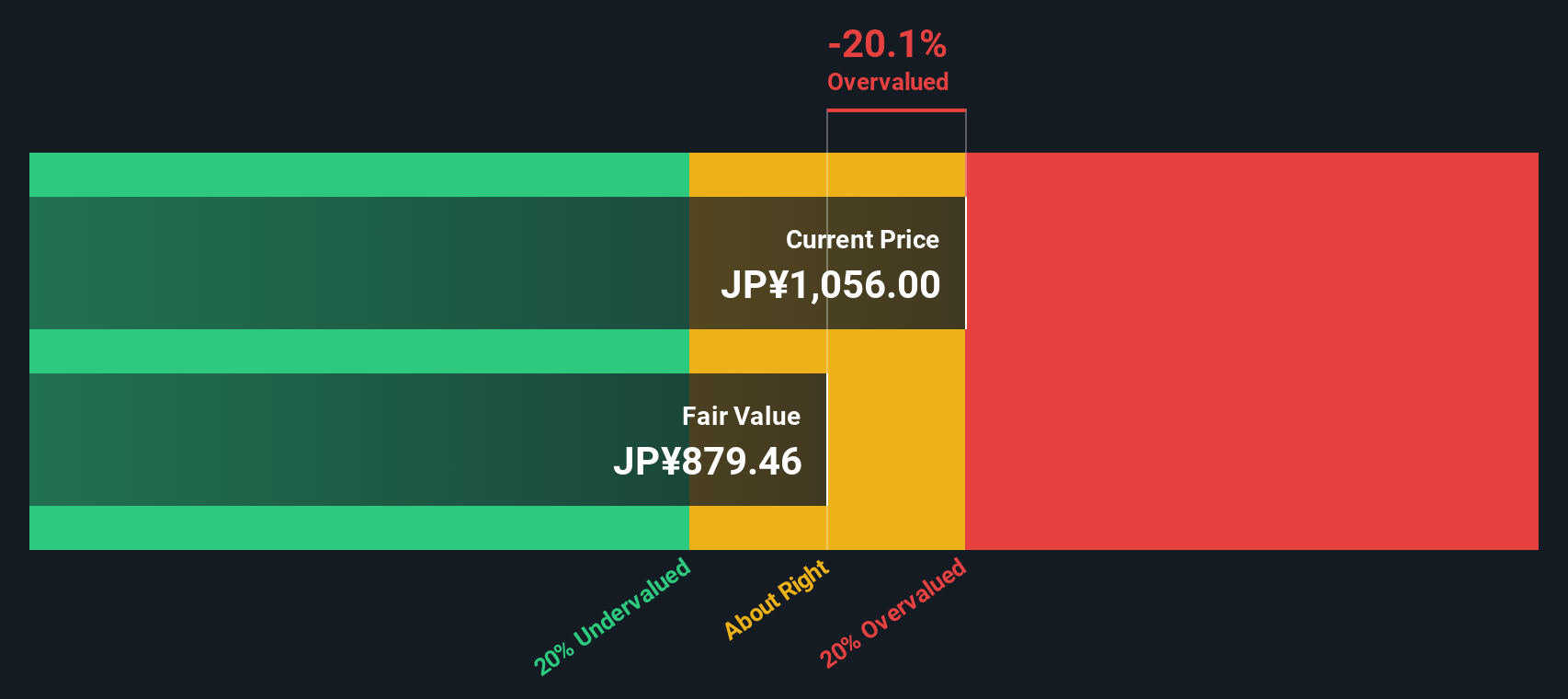Key Insights The projected fair value for Hokkaido Electric Power Company is JP¥879 based on Dividend Discount Model Hokkaido Electric Power Company’s JP¥1,056 share price signals that it might be 20% overvalued The JP¥1,263 analyst price target for 9509 is 44% more than our estimate of fair value
Does the October share price for Hokkaido Electric Power Company, Incorporated (TSE:9509) reflect what it’s really worth? Today, we will estimate the stock’s intrinsic value by estimating the company’s future cash flows and discounting them to their present value. Our analysis will employ the Discounted Cash Flow (DCF) model. Before you think you won’t be able to understand it, just read on! It’s actually much less complex than you’d imagine.
We would caution that there are many ways of valuing a company and, like the DCF, each technique has advantages and disadvantages in certain scenarios. If you want to learn more about discounted cash flow, the rationale behind this calculation can be read in detail in the Simply Wall St analysis model.
Trump has pledged to “unleash” American oil and gas and these 15 US stocks have developments that are poised to benefit.
The Method
As Hokkaido Electric Power Company operates in the electric utilities sector, we need to calculate the intrinsic value slightly differently. Instead of using free cash flows, which are hard to estimate and often not reported by analysts in this industry, dividends per share (DPS) payments are used. This often underestimates the value of a stock, but it can still be good as a comparison to competitors. We use the Gordon Growth Model, which assumes dividend will grow into perpetuity at a rate that can be sustained. The dividend is expected to grow at an annual growth rate equal to the 5-year average of the 10-year government bond yield of 0.5%. We then discount this figure to today’s value at a cost of equity of 4.7%. Relative to the current share price of JP¥1.1k, the company appears slightly overvalued at the time of writing. The assumptions in any calculation have a big impact on the valuation, so it is better to view this as a rough estimate, not precise down to the last cent.
Value Per Share = Expected Dividend Per Share / (Discount Rate – Perpetual Growth Rate)
= JP¥36.9 / (4.7% – 0.5%)
= JP¥879
 TSE:9509 Discounted Cash Flow October 2nd 2025 Important Assumptions
TSE:9509 Discounted Cash Flow October 2nd 2025 Important Assumptions
We would point out that the most important inputs to a discounted cash flow are the discount rate and of course the actual cash flows. You don’t have to agree with these inputs, I recommend redoing the calculations yourself and playing with them. The DCF also does not consider the possible cyclicality of an industry, or a company’s future capital requirements, so it does not give a full picture of a company’s potential performance. Given that we are looking at Hokkaido Electric Power Company as potential shareholders, the cost of equity is used as the discount rate, rather than the cost of capital (or weighted average cost of capital, WACC) which accounts for debt. In this calculation we’ve used 4.7%, which is based on a levered beta of 0.800. Beta is a measure of a stock’s volatility, compared to the market as a whole. We get our beta from the industry average beta of globally comparable companies, with an imposed limit between 0.8 and 2.0, which is a reasonable range for a stable business.
See our latest analysis for Hokkaido Electric Power Company
SWOT Analysis for Hokkaido Electric Power CompanyStrength Debt is well covered by earnings. Weakness Earnings growth over the past year underperformed the Electric Utilities industry. Dividend is low compared to the top 25% of dividend payers in the Electric Utilities market.Opportunity Good value based on P/E ratio compared to estimated Fair P/E ratio. ThreatDebt is not well covered by operating cash flow. Paying a dividend but company has no free cash flows. Annual earnings are forecast to decline for the next 3 years. Looking Ahead:
Valuation is only one side of the coin in terms of building your investment thesis, and it ideally won’t be the sole piece of analysis you scrutinize for a company. It’s not possible to obtain a foolproof valuation with a DCF model. Instead the best use for a DCF model is to test certain assumptions and theories to see if they would lead to the company being undervalued or overvalued. For instance, if the terminal value growth rate is adjusted slightly, it can dramatically alter the overall result. Can we work out why the company is trading at a premium to intrinsic value? For Hokkaido Electric Power Company, we’ve compiled three further items you should further research:
Risks: For instance, we’ve identified 4 warning signs for Hokkaido Electric Power Company (2 are significant) you should be aware of. Future Earnings: How does 9509’s growth rate compare to its peers and the wider market? Dig deeper into the analyst consensus number for the upcoming years by interacting with our free analyst growth expectation chart. Other High Quality Alternatives: Do you like a good all-rounder? Explore our interactive list of high quality stocks to get an idea of what else is out there you may be missing!
PS. The Simply Wall St app conducts a discounted cash flow valuation for every stock on the TSE every day. If you want to find the calculation for other stocks just search here.
Valuation is complex, but we’re here to simplify it.
Discover if Hokkaido Electric Power Company might be undervalued or overvalued with our detailed analysis, featuring fair value estimates, potential risks, dividends, insider trades, and its financial condition.
Access Free Analysis
Have feedback on this article? Concerned about the content? Get in touch with us directly. Alternatively, email editorial-team (at) simplywallst.com.
This article by Simply Wall St is general in nature. We provide commentary based on historical data and analyst forecasts only using an unbiased methodology and our articles are not intended to be financial advice. It does not constitute a recommendation to buy or sell any stock, and does not take account of your objectives, or your financial situation. We aim to bring you long-term focused analysis driven by fundamental data. Note that our analysis may not factor in the latest price-sensitive company announcements or qualitative material. Simply Wall St has no position in any stocks mentioned.


AloJapan.com